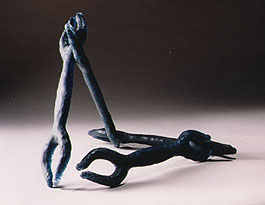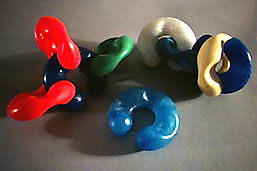Some of the The Work I made in Steven Paul
Day's Class at Pilchuck Glass School '94
I wanted to see if ceramic shell kiln
casting was anything for me.
I desides to try it on difficul shapes and found
out that if you have a sharp curve like the below pieces have the
ceramic shell is stronger than the glass and breaks the glass as it
cools down in the kiln, same as clay does.
I think I will stay with my clay molds
:)
They are much much cheaper
I can often reuse them
Enviromentaly wholesome compare to
.....
Don't need to make a wax piece
first
Give the work the charater that I
like
AND many other
+ + + + +
+ + + +

Four Blue Links
Ceramic shell kiln glass casting
1/2' x 1/4' x 3"


Toy Links
Plastic toy and glass
Ceramic shell kiln casting

This picture shows how some part of the Ceramic
shell kiln casting is done.
You create something in a material that can burn,
for example in wax. Then paint on the Ceramic Shell. Let each layer
dry. You do this until the covering is thick enough to hold the glass
you are going to put in ( a little bit more than a egg shell in most
cases). Then you burn out the wax either with a torch or in a kiln.
Let the cup turn down so the wax can run out. Have a pan or something
below to hold the wax that comes out. The mold will turn black from
the material that you are burning out and then that material is gone
the mold will turn white again .It will now be water resistance. To
get this material off your piece after it has been fired with glass
you use a sharp knife or a razor blade to pluck it off. Sometimes the
glass sticks to the Ceramic Shell and the only way to get it off,
that I know, is to sandblast the piece or grind it off.
Some of the things that didn't work but
good to learn so you don't do this mistake.

I wanted to attempt to make a piece that was
out of copper and glass fused together.
See picture below.

BUT I didn't know then that the copper gets
really brittle when it is heated up over 1300 F. Coppers anniealing
point is around 1000 if I remember right so from that point on it
starts to break down. Specially if you cook it for several hours like
I did to make sure the glass had run into the molds and filled
them.

Another thing was that not all glass types take
copper as well and when the glass cools the glass might break around
the areas that the copper is for it contracts more than the copper
does. I was useing.

So this is what came out.
The copper was too weak to hold up the glass
and the glass was fracturing around the copper that I had stuck into
it.
There are number of ways around a problem like
this .
What I have found to be the best solution is to
code a copper tube with kilnwash or plaster and put it into the
glass. Then you put the copper wire into the tubes in the cast glass
when you have finished coldworking your glass and time to see it in
one piece.
Back to my home page







